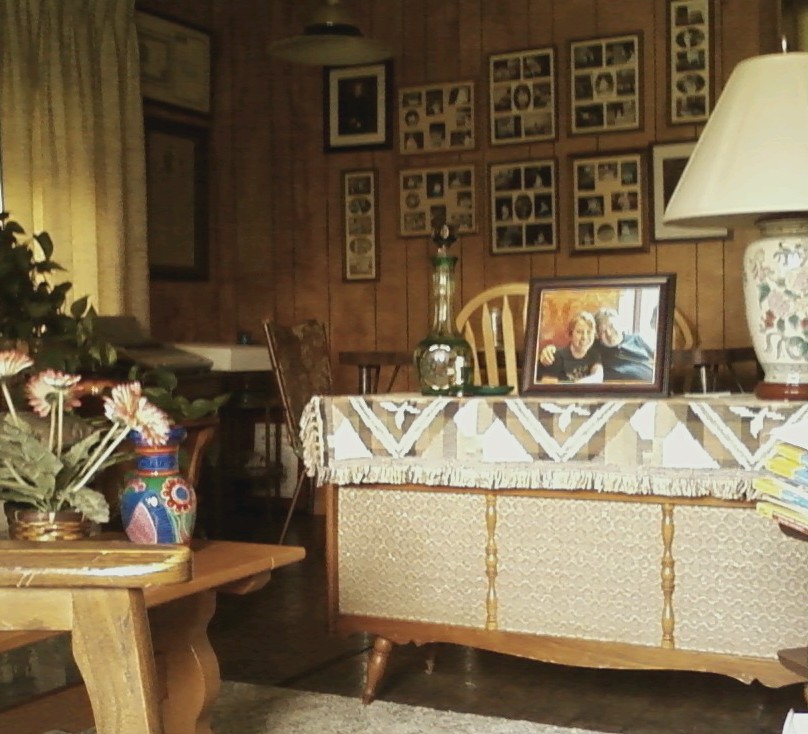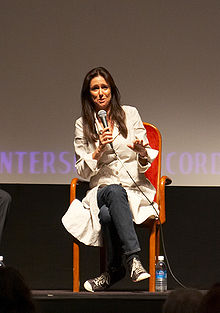“How hard it is, in literary criticism, to find words of praise. There are infinite gradations of blame, a thousand fresh and pungent metaphors for detraction, the epithets of dissatisfaction seem never to stale (perhaps that is why contemporary writings, and particularly contemporary essays, are usually noticeable only when they are abusive), but the moment one finds a work which genuinely impresses and delights, there seems no article of expression other than the clichés that grin at one from every publisher’s advertisement.”
Evelyn Waugh, “Art from Anarchy” (Night and Day, Sept. 16, 1937)
TT: Never enough stuff
Somebody tweeted the other day about an essay of mine that appeared in a coffee-table book called America at Home: A Close-Up Look at How We Live that was published in 2008. I’d completely forgotten that I wrote this piece, and had to look it up in my electronic files to recall what it was about. Though I no longer live in the apartment described below, I rather liked the piece on renewed acquaintance, and thought that you might feel the same way.
* * *
“Simplify, simplify,” Henry David Thoreau exhorted us in Walden, in which he tells how he spent two years living in a hand-built one-room shack so as to free himself from the shackles of stuff. Me, I live in a small New York apartment whose walls are lined with eight hundred books, three thousand compact discs, and thirty-six lithographs, etchings, screenprints, woodcuts, and watercolors, and it’s been five years since any of those numbers last trended downward. Middle-class Manhattanites typically live in close quarters, and I’m no exception: I keep my sauce pans in the oven and sleep in a loft. But that doesn’t stop me from wedging more stuff into my Upper West Side home, whose neatness (for I am very neat) arises from the fact that my closets are so full that the only way I can cram something new into them is to throw out something old.
I am, in other words, a collector, and chances are that so are you. Most Americans are collectors, though some are more systematic about it than others. The works of modern American art that I own, for instance, are a collection in every sense of the word, so much so that a friend started referring to my apartment as “the Teachout Museum.” Not that any of my pieces are priceless–I’m big on eBay–but they still amount to something more than a bunch of miscellaneous prints. That’s how you know you’ve amassed a collection: the whole is greater than the sum of its parts, which is a polite way of saying that you own too damn much of something for any immediately obvious purpose. My father collected mugs–but why? What did he get out of looking at the shelves on which dozens of dusty mugs were arranged as carefully and lovingly as I now hang the prints by John Marin, Milton Avery, Hans Hofmann, and Fairfield Porter that grace the walls of my living room? It never occurred to me to ask him. The mugs were as much a part of him as his deep voice, and that was that.
Are we what we collect? Sometimes the answer is self-evident. Louis Armstrong and H.L. Mencken, who in every other way were utterly dissimilar, preserved every scrap of personal memorabilia they could squeeze into their multi-story homes. I once spent a rainy afternoon leafing through Mencken’s old hospital bills. Both men, in essence, collected themselves, and with good reason, since they were great artists through whose self-collections scholars now rummage in search of insight. But even those of us who have no like claim on posterity seem no less compelled to collect something, be it mugs, lithographs, recipes, stamps, matchbooks, or plastic handbags. And while I know two collectors who have gone so far as to rent apartments devoted solely to the storage and display of their collections, it seems in the nature of most Americans to want to keep their stuff closer to hand. Not a few of the finest museums in America began life as the private homes of wealthy art collectors.
 Might it be that the presence of a collection, whether humble or haute, is part of what makes a house a home? If so, then it might also be that we are all self-collectors, and that our collections are, in Alec Wilder’s phrase, clues to a life. Perhaps my father, who spent the middle part of his life as a traveling salesman, had a story to go with each of his mugs. I know that each of the carefully framed family snapshots that hang on the walls of the house where he lived, and where my mother still lives, tells a little piece of the story of my family. They, too, are a collection, one of no value to anyone but my kinfolk, to whom they are as priceless as any of the Rembrandts hanging at the Met.
Might it be that the presence of a collection, whether humble or haute, is part of what makes a house a home? If so, then it might also be that we are all self-collectors, and that our collections are, in Alec Wilder’s phrase, clues to a life. Perhaps my father, who spent the middle part of his life as a traveling salesman, had a story to go with each of his mugs. I know that each of the carefully framed family snapshots that hang on the walls of the house where he lived, and where my mother still lives, tells a little piece of the story of my family. They, too, are a collection, one of no value to anyone but my kinfolk, to whom they are as priceless as any of the Rembrandts hanging at the Met.
Needless to say, you can’t take it with you, and so from time to time I make yet another virtuous but futile attempt to prune my shelves and clean out my closets. Frank Lloyd Wright, America’s greatest domestic architect, was a passionate stuff-hater who actually went so far as to design houses that were intended to prevent their owners from piling up needless, life-complicating possessions. In my heart I know he was right, and that the accumulation of too much stuff is a drag on the spirit. Yet I still can’t help but smile wryly when I remember that Kentuck Knob, one of Wright’s most beautiful residences, was later purchased by a British baron who collects…houses.
NOVEL
Wesley Stace, Charles Jessold, Considered as a Murderer (Picador, $15 paper). A bewitchingly clever historical thriller in which the lives and work of Peter Warlock, Constant Lambert, and Carlo Gesualdo are blended into the hair-raising tale of an unworldly music critic who writes an opera libretto for a flint-hearted composer who returns the favor in the most malevolent way imaginable. The author (better known in pop-music circles as John Wesley Harding) has done a virtuosic job of fusing fact with fiction, and the result is one of the few novels with a musical setting in which the background is rendered accurately. Absolutely not for musicians only, though those who already know the dramatis personae will be dazzled by the sure-footed skill with which Stace has put their real-life stories to novelistic use (TT).
TT: Almanac
“I am attracted only to music which I consider to be better than it can be performed. Therefore I feel (rightly or wrongly) that unless a piece of music presents a problem to me, a never-ending problem, it doesn’t interest me too much.”
Artur Schnabel, My Life and Music
TT: Peter Falk, R.I.P.
I’ve never laughed harder in my life than I did when I first saw this scene from The In-Laws in 1979–and I bet you can guess which line did the job on me:
TT: Joy in Runyonland
On Sunday I drove up to Massachusetts’ Barrington Stage Company to see a letter-perfect revival of Guys and Dolls, and in today’s Wall Street Journal I rave about it. Here’s an excerpt.
* * *
If “Guys and Dolls” isn’t the best Broadway musical ever written, then…but why go on? Everybody who knows and loves the show agrees that it’s as good as a musical can get. Frank Loesser’s score is a platinum mine–at least half of the 16 songs, including “If I Were a Bell,” “I’ll Know,” “I’ve Never Been in Love Before” and “Luck Be a Lady,” are take-it-to-the-bank standards–and the book, smartly adapted by Abe Burrows from the raffish short stories of Damon Runyon, is funny enough to stand on its own.
But no musical, however classic, is invulnerable to bad direction, and Des McAnuff’s miscast 2009 Broadway revival was an over-cooked scoop of mush soft enough to make anyone unfamiliar with “Guys and Dolls” wonder what the fuss was about. If only John Rando’s new Barrington Stage version had opened on Broadway instead of in the Berkshires! Mr. Rando, a master of musical comedy who won a Tony for “Urinetown,” gets everything right that Mr. McAnuff got wrong, and plenty more besides.
 The manifold virtues of this revival start with the stars. The four lead roles are played by top-class regional-theater performers with Broadway experience, all of whom sing as well as they act. Matthew Risch, lately of “Pal Joey,” is smooth and debonair as Sky Masterson, the high-rolling sharpie who wins the heart of Miss Sarah Brown (Morgan James), the dishy Salvation Army doll who longs to save the souls of all the heels on Broadway. Michael Thomas Holmes plays Nathan Detroit, the proprietor of the oldest established permanent floating crap game in New York, like a slightly nebbishy Harvey Keitel. Ms. James, a refugee from the cast of “Wonderland,” has classical-quality pipes and enough warmth to melt the heart of a bill collector in January. As for Leslie Kritzer, who stood out in “A Catered Affair” and “Sondheim on Sondheim,” she shines brightly as the tough but lovable Adelaide, a third-tier nightclub warbler who’s been engaged to Nathan for 14 years and doesn’t want to hear any more excuses.
The manifold virtues of this revival start with the stars. The four lead roles are played by top-class regional-theater performers with Broadway experience, all of whom sing as well as they act. Matthew Risch, lately of “Pal Joey,” is smooth and debonair as Sky Masterson, the high-rolling sharpie who wins the heart of Miss Sarah Brown (Morgan James), the dishy Salvation Army doll who longs to save the souls of all the heels on Broadway. Michael Thomas Holmes plays Nathan Detroit, the proprietor of the oldest established permanent floating crap game in New York, like a slightly nebbishy Harvey Keitel. Ms. James, a refugee from the cast of “Wonderland,” has classical-quality pipes and enough warmth to melt the heart of a bill collector in January. As for Leslie Kritzer, who stood out in “A Catered Affair” and “Sondheim on Sondheim,” she shines brightly as the tough but lovable Adelaide, a third-tier nightclub warbler who’s been engaged to Nathan for 14 years and doesn’t want to hear any more excuses.
None of these four pros needs help to make a strong impression, but Mr. Rando, working in tandem with Joshua Bergasse, the show’s choreographer, surely deserves plenty of credit for sharpening the focus of their characterizations. Every plot point is put across with the unobtrusive crispness of the comradely kiss that Sky plants atop Adelaide’s head at the end of the reprise of “Adelaide’s Lament.” The laughs are there, but so is the feeling: You never forget that “Guys and Dolls” is not just a comedy but also a double-barreled love story, and you believe at all times in the truth of the underlying emotions that give meaning to the jokes….
* * *
Read the whole thing here.
TT: See me, hear me (cont’d)
I’m one of the panelists on the latest episode of Theater Talk, which will be telecast by CUNY-TV on Saturday at 8:30 p.m. ET (followed by several repeat airings). Joining me are fellow drama critics Adam Feldman, Jacques le Sourd, and Elisabeth Vincentelli. The hosts are Michael Riedel and Susan Haskins. We’ll be talking about the Broadway season just ended, and I can promise you that the discussion, which we taped a few weeks ago, will be frisky.
For more information, go here.
If you want to watch it now, here’s the complete episode:
TT: Julie Taymor’s complaint
The ex-director of Spider-Man: Turn Off the Dark is still making news, and the news she’s making is the subject of my “Sightings” column in today’s Wall Street Journal. Here’s an excerpt.
* * *
Blame it on Twitter. So says Julie Taymor, who claims that she got fired from “Spider-Man: Turn Off the Dark” because unhappy audience members who saw the show in previews took to social media in droves to complain, spinning a web of negative buzz that ultimately led to her dismissal as the show’s director.
 “Twitter and Facebook and blogging just trump you,” Ms. Taymor said at a recent meeting of the Theater Communications Group. “When you’re trying to create new work, and you’re trying to break new ground and experiment, which seems an incredibly crazy thing to do in a Broadway environment, the immediate answers that audiences give are never going to be good.” She added that the producers’ decision to rewrite the book of “Spider-Man” based on the input of focus groups was a mistake: “It’s very scary if people are going more towards that, to have audiences tell you how to make a show. Shakespeare would have been appalled.”
“Twitter and Facebook and blogging just trump you,” Ms. Taymor said at a recent meeting of the Theater Communications Group. “When you’re trying to create new work, and you’re trying to break new ground and experiment, which seems an incredibly crazy thing to do in a Broadway environment, the immediate answers that audiences give are never going to be good.” She added that the producers’ decision to rewrite the book of “Spider-Man” based on the input of focus groups was a mistake: “It’s very scary if people are going more towards that, to have audiences tell you how to make a show. Shakespeare would have been appalled.”
Ms. Taymor got one thing right: It’s crazy to experiment on Broadway, especially if you’re doing it with somebody else’s $70 million. But the rest of her lament was alternately self-serving and ill-informed, as anyone familiar with the history of New York theater could–and should–have told her.
Let’s start with the self-serving part. Ms. Taymor seems to think that her attempt to create a groundbreaking work of theatrical art was sabotaged by a horde of philistines who just didn’t get it. Er, how’s that again? “Spider-Man: Turn Off the Dark” was, and remains, a commodity musical about a comic-book character. No matter how well they’re done, commodity musicals are not high art. Even if they’re supremely artful, like Ms. Taymor’s “The Lion King,” they’re still applause machines whose main function is to make pots of money for their backers.
As for the alleged culpability of social media, it’s true that Twitter, Facebook, and the Broadway-oriented message boards have accelerated word of mouth to the speed of light. It’s also true that innovative artistic ideas need time to be perfected–and to be assimilated by those who are seeing them for the first time. And social media definitely spread the word about the problems of “Spider-Man” early on, though much of the sharpest criticism was written not by furious fanboys but by thoughtful commentators who, like Chris Caggiano, author of the theater blog “Everything I Know I Learned From Musicals,” are at least as smart as the best print-media critics.
All this notwithstanding, the truth is that Broadway hasn’t been changed all that much by Twitter….
* * *
Read the whole thing here.
